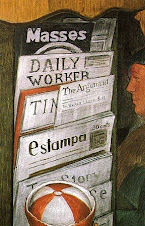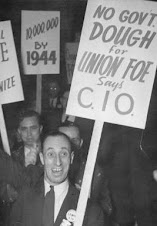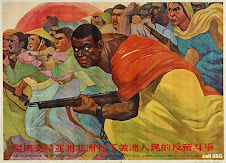By Martha Grevatt
Editor’s note: The writer has been a UAW Chrysler worker for 24 years, first in Ohio and now in Detroit. She has written extensively for Workers World newspaper on the crisis facing autoworkers. Grevatt is the author of the pamphlet, “In Our Hands Is Placed a Power: The Flint Sit-down Strike” and is working on a book on the same subject. Following are edited excerpts from a speech by Grevatt at a Workers World Party public forum in Detroit on Feb. 11.
Feb. 11 is the 75th anniversary of the victory of the 1937 Flint Sit-down strike, one of the most significant events in U.S. labor history. After occupying General Motors plants for 44 days, workers won recognition of the United Auto Workers and the first industry contract. This victory set off a chain reaction. Not only autoworkers but workers in steel, textile, retail, restaurant, public service and other sectors won union recognition. During this year of working class upsurge, African-American workers as well as Latino/a, Asian, Native, immigrant and women workers, played a pivotal role.
This is a big anniversary — 75 years, three-quarters of a century — of a very big event.
The sit-down in Flint began Dec. 30, 1936, and ended in victory on Feb. 11, 1937. Back then, they were part of their own Occupy movement of the time — against the 1%, whose system, capitalism, had plunged millions into unemployment and starvation while millions more toiled at backbreaking speeds to meet demands for more and more production.
It was in the 1930s that sit-downs gained worldwide popularity. In 1934, coal miners went on hunger strikes and stayed underground for several days in Yugoslavia, Poland and Hungary. They said they would rather starve quickly than slowly on starvation pay. Their pay was raised. Miners staged sit-downs in Spain and Wales in 1935 and in Poland, France, Scotland and again in Wales in 1936.
Polish workers were shut out of a rubber plant in 1936. In India that year, 5,000 textile workers sat down and won payment of back wages for overtime and a pay increase. By the end of 1936, French workers in every economic sector were staging sit-downs; over a million workers took part.
Sit-downs spread through U.S.
In 1936, the rubber workers in Akron, Ohio, became the first to make widespread use of the tactic in the United States. They got the idea from baseball players who sat down on the field and refused to play until they were given a union umpire. Workers at Firestone sat down Jan. 26 over speedups and the firing of a union committeeman. The committeeman was rehired. When Goodyear laid off 70 tire builders, 137 workers sat down in protest. They were fired, which led to a strike that idled 14,000 workers, and the workers were rehired.
After that there were sit-downs all through the year when disputes erupted — about one a week that lasted more than 24 hours and many more of a shorter duration. Sit-downs — I’ve read that the rubber workers invented the word — really worked. Akron was the proof! The big issue there was that workers worked six days a week, but only six hours a day because the work was so hard, and the companies wanted to go to an eight-hour day, still six days a week, with no increase in pay. That would cause a lot of layoffs. The workers were able to stave that off.
The Akron success encouraged the French sit-down wave, which in turn, by its breadth and scope and effectiveness, encouraged the widespread implementation of the sit-down strike in the U.S. that culminated in the Flint sit-down.
The Goodyear strike was the first big win for the newly formed Committee on Industrial Organization. The CIO was started as a committee of eight unions inside the American Federation of Labor to push for industrial unionism. The conservative AFL practiced craft unionism, focusing on skilled white male workers on a trade-by-trade basis, and resisted the demand to organize the masses of industrial workers by industry.
The CIO welcomed all workers, organizing African-American, Latino/a, Asian, Native, women and immigrant workers who worked in steel, auto, textile, rubber, retail, food service and the public sector.
While not one of the original eight unions, the UAW, which like the CIO was founded in 1935, quickly affiliated. The first auto sit-down was at a Bendix parts factory in South Bend, Ind., and it lasted a week. Midland Steel and Kelsey-Hayes followed. Not only in rubber plants, but in auto plants, this tactic worked.
Why a ‘state of occupation’?
Workers are less vulnerable when they take over the inside of a plant. From 1929 to 1936 no less than 96 workers were killed on the picket line in the U.S. During the worldwide sit-down wave of 1934 to 1937, the only workers killed in a sit-down were six Polish rubber workers in 1936.
Mary Heaton Vorse, a labor journalist who observed the many struggles of the 1930s, wrote:
“The strikers are far less vulnerable than they are on the picket line because employers hesitate to attack the sit-downers when it may injure their own property. The sit-down effects a complete tie-up and the workers are protected against violence and strikebreakers, from cold weather and the rain. The plant is completely closed and scabbing is impossible; as a training ground for education, it is far better than the ordinary strike.”
The New York Times, speaking for the ruling class, lamented that “once a sit-down strike has become a state of occupation, there is little a company can do.”
The ones who were about to launch the historic Flint sit-down had closely watched the events in Akron and France and understood these class dynamics. Building on the successes in Bendix and the Detroit supplier plants, they set out to take on Goliath: General Motors. They had to strike Flint, Mich., the heart of GM’s world empire.
Workers were fed up. Working on the line was hell, and when you got halfway used to the pace, the speedup came. You could be fired for anything or nothing.
Communists, Black workers organize
There were 10 plants in Flint. Fisher Body 1 supplied the whole company with stampings. Shutting it down was critical. The lead organizer and strategist was Bob Travis, a union militant who became a Communist Party member during the big Chevrolet strike in Toledo, Ohio, in 1935. He had been recommended by UAW Vice President Wyndham Mortimer, also a Communist, who had successfully organized auto plants in Cleveland. Mortimer had come to Flint in June of 1936 to rebuild the union. He would leaflet the plants — and the leaflets made their way down the line — with a class-conscious message.
Mortimer believed it was critical to involve Black workers in the organizing drive. He met with them in the basement of an African-American church and workers’ homes. To protect their identities they met in near-dark; the only light was a single candle. They had good reason to be afraid. The “Black Legion” was a Klan offshoot that wore black robes instead of white.
The Legion terrorized the Black community and union organizers. Their most famous casualty was the Rev. Earl Little, the father of Malcolm X, murdered outside Lansing, Mich. Their robes were rumored to have been sewn by pro-company women working overtime in GM’s upholstery plants.
Unlike Mortimer, Homer Martin, the UAW president at the time, was not so progressive. In fact, he was a fan of the notorious Father Charles Coughlin, now seen as the father of hate radio. Martin pulled Mortimer out of Flint, but sent Bob Travis in his place.
Travis had comrades inside Fisher 1. But how to get a sit-down going? There was a dress rehearsal in November. Management tried to cut the number of workers on a particular job, and three workers got in an argument with the boss, which stopped the line. The line got moving, but the next day, two of the workers, the Perkins brothers, found their time cards gone. Workers stopped work. They stood still. The brothers were rehired. Management had to have Flint police locate them and tell them they got their jobs back. It could be done!
A Fisher Body plant in Cleveland also produced stampings. Workers at that plant sat down on Dec. 28. The mighty presses were silenced. Two days later, the Cleveland strike moved outside. On Dec. 30, rumors swirled about the Flint Fisher plant that stamping dies were being moved out of the plant. At a lunchtime meeting, Travis asked the workers what should be done. Cries rang out, “Shut her down!” Before the end of the shift, an occupation was in progress. The Fisher Body 2 plant had already been taken over earlier that day.
Workers from other plants, along with family members of the sit-downers, kept the mass picketing going night and day. Women played an indispensable role, keeping the men fed, providing day care for women picketers’ children, administering first aid, and tackling many other essential tasks.
GM was a Jim Crow operation then. In most plants Black workers were only employed as janitors. The exception was the Buick foundry, where conditions were the worst, and Black workers’ jobs were the worst of the worst. The Buick plant was not on strike, but was idled, and Henry Clark and Prince Combs, in whose homes the dimly-lit organizing meetings had occurred, built support for the union. J.D. Dotson was a Black Communist who carried messages from one picket line to another and in and out of the occupied plants.
On Jan. 11, Flint police decided to storm the plants. This was easier said than done. The workers had been making piles of door hinges and other heavy metal parts. The police were subjected to a hail of these now, hurled from the second floor, along with water hoses turned on them in zero degree weather. The fight raged on, and 12 or 13 strikers were injured by gunfire, along with a supporting striking bus driver. But in the end the cops fled. They ran, and the battle is known as the Battle of Bulls’ Run.
Indispensable role of women
During the Battle of Bulls’ Run, the women showed unprecedented determination. Genora Johnson was the spouse of a Chevy worker and a member of the Socialist Party (and later the Socialist Workers Party). Her immortal words in the heat of battle gave strength to the battered strikers. “Cowards! Cowards!” Johnson shouted at the police, “Shooting unarmed and defenseless men!” She then called on the women to “break through those police lines and come down here and stand beside your husbands and your brothers and your uncles and your sweethearts.” The women, nearly 1,000 of them, heeded her call.
After that fight, Johnson organized the Women’s Emergency Brigade. Only women who felt they could respond to an emergency at a moment’s notice were asked to take the Brigade’s pledge. Told to “expect to face tear gas and bullets on the picket line” and that “you will have to remain strong and fighting even when your sister falls by your side,” 400 women signed up right away. They were on call 24 hours a day, seven days a week.
The Brigade demonstrated its fortitude whenever the police appeared poised to attack. The New York Times reported that strikers had “a large supply of blackjacks … whittled down so that they can be swung or jabbed readily.” In fact, the clubs had been whittled down by the Women’s Brigade to fit their smaller hands.
Leola Combs, spouse of Prince Combs, was one of the women very active in the Brigade.
Bulls’ Run was a real morale booster. If GM bosses thought breaking the strike would be easy, they were wrong. But the company wasn’t about to give in easily. Both sides were holding their ground. What could break the stalemate?
Chevrolet Plant 4 supplied all the Chevy assembly plants in the country with motors. A workers takeover there would hit GM hard. But the plant was heavily guarded. Kermit Johnson, spouse of the Brigade Captain and also a Socialist, is credited with devising the plan. At a mass meeting, where it was assumed there would be company spies (that year GM spent almost $1 million on spies) it was announced that there would be a takeover of Chevrolet Plant 9 — not particularly critical to GM’s operations — on Feb. 1. True to form, the spies ratted out the union, and all of the guards and the police converged on Plant 9.
The Emergency Brigade were the true heroes that day, fighting off the cops and, as captured in famous video footage, smashing the windows to let out the tear gas that the cops fired into the plant. And the sit-down at Plant 4 was underway. When word got out, the women held back the police until the plant was firmly in the hands of the workers.
Building multinational workers’ unity
One of the heroes inside Chevy 4 was Roscoe Van Zandt, an African-American worker. He stayed inside the plant from beginning to end. This was dangerous for a Black worker, and most accounts of the Flint struggle name him as the only one who stayed inside. At first, he kept to himself, but Socialists like Johnson and Howard Foster educated the white workers on the need for solidarity. There was one bed in the plant, and they gave it to Van Zandt. James Todd, whom I interviewed five years ago — I saw him yesterday at the commemoration in Flint. He is still strong at 98 — described Van Zandt as a natural leader.
Immigrant workers were also very active in the strike. Most of them were from Eastern Europe and the majority of them were Polish. They left as a group from a meeting at the Polish hall when they heard about Bulls’ Run in progress. At least one Mexican immigrant, Rafael Arceo, is known to have joined the union in 1936, and he stayed inside for the entire duration of the Fisher 1 sit-down.
Well, the strike continued. Neither the cops, the company’s paid vigilantes (known as the Flint Alliance, they tried to organize a “back to work” campaign), the Michigan National Guard, nor court injunctions could break the workers’ resolve.
Seventy-five years ago today, on Feb. 11, 1937, the workers marched out of the plants, triumphant. GM had signed a contract recognizing the union in 19 key plants. Delirium filled the atmosphere. Tens of thousands celebrated in the streets.
Soon after, all of GM was unionized.
Sit-down fever spread like wildfire. Hundreds were reported and hundreds more went unreported. Every sector of the working class got in on the act: Women at Woolworths and other department stores; textile workers protesting sweatshop conditions; hospital workers in Brooklyn; and city workers in Chicago, who shut down a drawbridge during rush hour. Even blind workers in a workshop and prisoners sat down to win better conditions.
Chrysler fell in line, agreeing to negotiate with the UAW after a 31-day sit-down at six Detroit plants. The strike continued with outside picketing, and in a short time, Walter P. Chrysler recognized the UAW as the sole bargaining agent.
All of Detroit was engulfed. This was true class unity. I remember years ago reading an article, I think the title was “Not Your Father’s Labor Movement.” The theme was that today’s labor movement, with so many women and workers of color, is different from that of past eras — that in the “old days” it was mainly a white male movement. That was never true. In the 1930s, hundreds of thousands of the most oppressed workers showed great militancy and courage — they poured into the CIO. The great organizing drives would probably have failed if it had been otherwise.
Flint is a great example of the importance of unity of Black and white workers. Communists like Mortimer and Travis understood this and went to great lengths to make Black and immigrant workers feel welcome in the UAW.
J.D. Dotson described what it was like before the UAW. The workforce was completely segregated, and African Americans had to use separate entrances or they would be fired. The exception, Dotson recalled, would be during a strike: “They put them in boxcars and bring them over here in the factory. ... So they would stay in there and work for little or nothing until the white man's money run out. Then when the white people's money run out when they was ready to come back to work then they would turn the dark folk like garbage back on the streets.” Crimes like that didn’t happen after the sit-down.
Henry Clark, Prince Combs, Ellsworth Steen and Johnson Buchanan were leaders in the drive to organize the Buick plant. They were respected by all of the workers. Clark was often a delegate to early UAW conventions; at one held in Grand Rapids, Mich., three of six Flint delegates were African Americans.
This is not to say that segregation in the plants ended with the victories of 1937. In fact it still exists today. It was not until World War II and the retooling for war production that assembly line jobs were open to Black workers. Because a foundation of solidarity had been built during the sit-down, Flint was an area where there was relatively little resistance to Black workers coming into the plants.
Subscribe to:
Post Comments (Atom)










































No comments:
Post a Comment